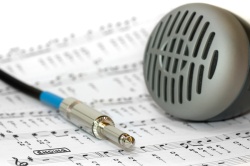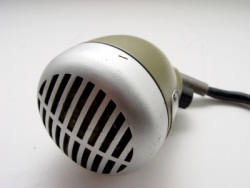There’s No Place Like Ohm – Microphone Impedance
Our previous article in the Harmonica Microphones series mentioned impedance. Here we describe not so much what it is, but what it means to harp players wielding microphones.
 The microphones we are talking about in this series of articles are referred to as either “high impedance” or “low impedance.” In general, a vintage bullet mic is a high impedance device and a modern vocal mic is a low impedance one. This is not always the case, however.
The microphones we are talking about in this series of articles are referred to as either “high impedance” or “low impedance.” In general, a vintage bullet mic is a high impedance device and a modern vocal mic is a low impedance one. This is not always the case, however.
 So we should find out what kind of microphone we are holding in our hand (the general rule above and a quick Google should reveal all). Once we know that, the following facts hold true:
So we should find out what kind of microphone we are holding in our hand (the general rule above and a quick Google should reveal all). Once we know that, the following facts hold true:
- Microphones and amplifiers work best with certain load or drive levels, respectively. We want to optimize the power transfer from mic to amplifier. For this reason, it is desirable to choose a microphone with an impedance that equals the impedance of the device it is connected to – an amp, a foot pedal, a wireless transmitter, a mixer, or what have you. Ideally we plug a low impedance mic into a low impedance input, or a high impedance mic into a high impedance input. If we can’t acheive this, there is an alternative…
- We can use an impedance matching transformer: a simple device that can “match” (or adjust) a low impedance mic to a high impedance load, or vice versa.
- Low impedance systems were developed after high impedance ones, and were designed to enable much longer cable runs and better reject noise (like hum) that is picked up by the cable.
- There’s no difference between low impedance and high impedance microphones if you are looking to improve your tone and get better resistance to feedback. Merely switching from one kind of microphone to the other will not guarantee improvement.
- Low impedance systems are almost always wired with XLR jacks and plugs. This is a worldwide industry standard.
- Many different kinds of connectors are used for high impedance devices, including XLR. However when XLR is used, the cable-to-pin wiring is not the same as it is for low impedance XLR. Mixing low- and high-impedance cables and mics just because you can connect them together with XLR can lead to poor performance. When you see a 1/4″ jack or plug (like guitar players use) it’s a safe bet that you’re looking at a high impedance device. The same is true for the “screw-on” connector that was made by Switchcraft and Amphenol, which was found on many vintage mics and is still produced today.
- There’s nothing wrong with connecting a high impedance mic with an XLR connector to a high impedance load (like an amp) with a cable that has XLR at one end and a 1/4″ connector at the other. There is something wrong, however, with using that same cable to connect a low impedance mic to the amp – because there is an impedance mismatch. In this case a proper low impedance (XLR to XLR) cable should be used, together with an impedance matching transformer.
Technical note: By definition, impedance is “a measure of the opposition to the flow of alternating current through a circuit” , that current being the signal from your mic, which in loose terms is an electrical picture of the sound going into it. POWER in electrical terms is the rate at which electrical energy is fed into or taken from a device or system. You can have the same amount of power with low voltage and high current, or high voltage and low current. Low impedance mics have a signal with more volts and less current; high impedance mics are the reverse.
 Now we’re all matched up and our power transfer is optimal… SKREEEK, SKRONNK! Uh oh, feedback. If you’re a harp player with a microphone, chances are you’ve heard that awful sound. Next time around, we’ll tell you why it happens and how to manage it.
Now we’re all matched up and our power transfer is optimal… SKREEEK, SKRONNK! Uh oh, feedback. If you’re a harp player with a microphone, chances are you’ve heard that awful sound. Next time around, we’ll tell you why it happens and how to manage it.
Greg Heumann is curating our Harmonica Microphones section. Read his previous articles here. You can find more from him at www.blowsmeaway.com.

Trying to do some research on a mic I acquire but I do not know anything about this subject. What I have is a Calrad Dynamic microphone DM-9 on a short stand. Can anyone tell me about it??
thanks for your time,
Richard
Hi Rich, I’ll see what I can find out for you. Doc
i,ve got a green bullet microphone,what will i need to set it up with a powerful valve amp,to get that chicago blues sound,like a 59 bassman to match a band. champion mr eubanks.
Hi Francis. Seems you already have the answer! A good valve amp, probably with 10″ speakers rather than 12″. The Bassman has no reverb, so you will need to invest in a reverb pedal or tape loop. Analogue rather than digital reverb is considered more desirable to purists. I just invested in a new Fender 2×10″ TV front Bassman and it’s killer. Why did I buy it? I had the luxury of a spare couple of hours in the local amp store, and a patient assistant. I tried a variety of amps and found myself tweaking everything to find that Chicago grit and depth. Nothing quitebcut it. Then I tried the TV front Bassman. It did what I needed as soon as I plugged in. No tweaks. Crunch. Whoomph. Depth and warmth. Beautiful. It told me it was the right candidate for the job, even at low volume. I knew by what my ears and guts were picking up. It was pointless trying anything else. End of. So, read up. Go searching. Try as many amps as you can. Trust to your on board satnav system! Let us know how you get on. Doc
Hi. I have a Shure SM58 vocal mic. that I would like to use with a 10 watt
Epiphone Electar Tube 10 Valve amp as the vocal mic is low impedance output via XLR
male pins but the amp is 1/4″ jack fitting can I get a transformer that will take the mic.
outlet and let me plug a lead into it ? will I need to have a lead made up with these
different plugs and will they play thru and give me the signal boost that the amp demands?
Thanking you in advance ———- jumpjive65jive
.
Blimey John is that Klingon? While I decipher your message, I’ll see if anyone else can be of any help. My rig is still steam driven…. Thanks for getting in touch. I’m gonna skin Murray and his mic posts alive :o)
Very informative – thanks! I do have one question – I have a CR element in a JC30 shell and I’ve just aquired a MC-151 crystal element, again in a JT30 shell. Through the same amps (a Silvertone 1482 and a 1484) The CR mic sounds great but the 151 is lacking bite and volume. I’m assuming this is because of the different impedances. Both mics have the jack socket adapters and ideally I want to be able to swap mics by just uplugging one and plugging in the other, so tinkering with the amp isn’t going to help. Is there anything I can do with the crystal mic, within the mic, to match the impedance? Thanks! 🙂 Mark.
Hi Mark, we’ve put the word out and will let you know what we hear :o)
Hi again Mark, here’s some feedback from Johnny Ace..
Sounds Like the Crystal has lost most of its punch. As you probably know crystals are famous for losing most, if not all, of their strength over time (because of the salt). Let me know, or ask Mark to contact me if you like. Hope all is well, Johnny
https://johnnyacemics.wordpress.com/
And also some input from Greg Heumann at Blowsmeaway..
The amp’s input impedance can play a role, but I suspect that the real problem is that the crystal element is already dying. That is the case about 95% of the time with those elements. The only way to know for sure is to compare it with a known 100% output element. Greg Heumann
http://blowsmeaway.com
http://facebook.com/blowsmeawayproductions